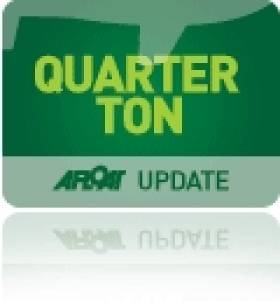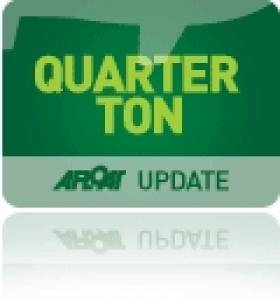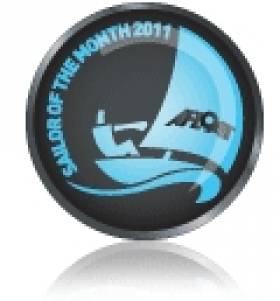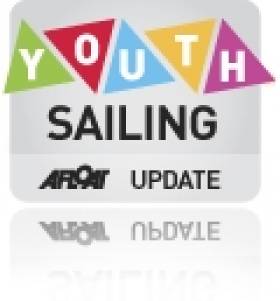Displaying items by tag: George Kenefick
Royal Cork's Tiger Attacks at Cowes Quarter Ton Cup 2012
#quartertoncup – In the all amateur Corinthian Division of the Quarter Ton Cup in Cowes the defending champion Tiger and her young crew led by George Kenefick from Royal Cork (ably assisted by Mike Budd), leads the fleet with five first places and a black flag. The battle for second is tied between Paul Kelsey's Runaway Bus and Richard and Anna Thomas's Sergeant Pepper, both stalwarts of the Coutts Quarter Ton Cup, who each count eleven points, putting them six points behind Tiger. Eric William's delightful little Love In A Mist, the smallest boat in the fleet is fourth with Dun Laoghaire's Ken Lawless & Sybil McCormack's Supernova fifth. Royal Irish club mate Paul Colton's Cri-Cri is sixth and Lucy Wood and Tara Stone's Rum Bleu seventh.
Whilst the weather may have been overcast on day two of the Coutts Quarter Ton Cup the fleet most definitely was not and the 30 teams enjoyed three more stunning races. It was a day of high drama in every sense with constant parry and thrust on the race course and the black flagging of four of the top ten boats in race six. With the discard not coming into play until a seventh race has been sailed the black flags hit the overall results hard. Those affected were Rickard Melander's Alice II, Rob Gray's Blackfun, George Kenefick's Tiger and Louise Morton's Espada, all of whom are ranked in the top ten.
The Irish teams had another great day with Ian Travers and Eamon Rohan's Per Elisa and Diamund Foley's Anchor Challenge, being helmed this week by Paul Gibbons, both putting in solid results. Per Elisa won race four, stumbled with a fourteenth in race five but came back with a fifth in race sixth to move up from ninth overall to fifth. Anchor Challenge struggled in the first race finishing twenty-first but then won races 5 and 6 which shunts them from fifth to third overall, six points behind Aguila.
Six Irish Boats Competing for Quarter Ton Cup in Cowes
#quarterton – Ireland will be out in force next Monday with six entries and three new teams competing for the Quarter Ton in Cowes. The three new teams are Paul Coulton's Cri Cri, a recently refitted 1979 Alain Jezequel design; Jason & Dominic Losty's Fauroux designed Illes Pitiuses; and Diamund Foley who now owns Espada's sistership Anchor Challenge.
Irish sailor of the year George Kenefick and his young team aboard Tiger, the 1989 Fauroux previously known as ASAP, will also be crossing the Irish Sea once again to defend their Corinthian title for all amateur crews. Tiger, the ICRA Class 3 champion, has just undergone some keel surgery - having just been fitted with a Mills Keel.
The Corinthian Trophy was first awarded in 2011 and is expected to be hotly contested again this year. Ken Lawless and Sybil McCormac make a welcomed return on Supernova, with the final Irish Entry this year being Eamon Rohan's and Ian Travers' Ceccerelli designed Per Elisa which won the last two IOR Quarter Ton Cups in '95 and '96.recent aquisition has just completed an IRC optimisation in Cowes. This boat won the last two IOR QTC's in'95 and 96'. She has been fitted with a new rig and David Hollom designed fin keel. A retro styling completed her refit. Per Elisa wil be staffed by former Blondie IV crew from the Royal Cork, KYC and the UK.
Jason Dominic Losty's Fauroux designed Illes Pitiuses was refitted along-side Per Elisa over last winter in Cowes. Being a near sistership of the formidable Tiger, she is sure to be fast out of the traps. She is being crewed by a comination of Cobh and Royal Cork Crew including notables such as Kieran Dorgan and Dave Rose.
Foley will be sailing the Farr designed Anchor Challenge with Mark Mansfield (recent 1720 National Champion) with the balance of crew coming from Royal Cork Yacht Club. Notables includes Mansfields former Olypic partner- Killian Collins and Paul Gibbons of recent Tiger fame. Anchor Challenge won the QTC in 2010 so is a definate force to be reckoned with this year.
The eighth edition of the Coutts Quarter Ton Cup revival regatta will be hosted by the Royal Corinthian Yacht Club, Cowes, from Monday 25 to Wednesday 27 June 2012. The event will bring together Quarter Tonners from across the UK and Europe to enjoy three days of competitive sailing, camaraderie and fun.
These historic little ships hold a very special place in the hearts of many sailors and each year more boats are rescued from neglect and brought back to their former glory by their enthusiastic owners. Owning a Quarter Tonner is a little bit like owning a vintage car and their owners put just as much time, money and love into rebuilding and maintaining them as any classic Bentley or Alvis owner. The original Quarter Ton Cup competition was raced annually from 1967 to 1996 and was the World Championship for small offshore racing boats. Many of today's top sailors and yacht designers cut their teeth in the class and a lot of the designs were truly unique and revolutionary in their day.
Joining the Coutts Quarter Ton Cup revival fleet for the first time this year will be Peter Morton's new boat Bullit, a Fauroux design from 1977 which won the 1979 and 1980 Quarter Ton Cups and has just been completely refitted. Morty's crew will include the infamous Kelvin Rawlings, without whom the Coutts Quarter Ton Cup would not be complete, and Jules Salter who loves the event so much that he will fly in specially from the Lorient stop-over of the VOR to participate!
Past ISAF Vice Chairman George Andreadis is also be returning to the Quarter Ton Fleet for the first time in 21 years with Atalanti IV, the boat he had built by Jeremy Rogers to Rob Humphries' design for the 1991 Quarter Ton Cup where she finished 6th. Atalanti IV has been in George's famous yacht storage facility ever since the end of the 1991 Cup, but she returns to the water this summer looking absolutely stunning following a full refit. Having just come second in the Quarter Ton Class at the 2012 Vice Admiral's Cup George will no doubt be hoping for a podium finish in the Coutts Quarter Ton Cup too.
Class regular Rob Gray also has a new boat this season in the shape of Black Fun, a 1976 Laurie Davidson design which won the '76 New Zealand Quarter Ton Championship with four straight wins. We also look forward to welcoming Freres Sur Mer, a 1981 Fauroux design from the Netherlands.
Joining the newcomers will be a host of familiar faces led by reigning Coutts Quarter Ton Cup holder Louise Morton and her crew aboard the 1980 Bruce Farr designed Espada. Also keen for a crack at the trophy will be Rickard Melander from Sweden sailing the 1990 Phil Morrison designed Alice II. Stalwarts of the Coutts Quarter Ton Cup, Rick and his crew have been gradually improving their performance each year and, having just won the Quarter Ton Class at the Vice Admiral's Cup, clearly have their sights firmly setting on the main event. Other regulars will include Graydon Dawson's Diamond, Willy McNeil and Mike Pascall's Illegal Immigrant, Ian and Catrina Southworth's Whiskers, Menace owned by Derek and James Moreland and Tim Rees, Paul Treliving's Odd Job and Paul Kelsey's Runaway Bus.
With so many new teams joining the regulars an excellent turnout is expected. Racing will take place in the Solent with social events being held each evening at the Royal Corinthain Yacht Club's delightful Cowes clubhouse. The Coutts Quarter Ton Cup Gala Dinner will take place on Tuesday 26th and the guest speaker will be sailing legend Brian Thompson, who holds 27 sailing world records, has sailed more offshore racing miles than any other Briton and who will also be racing in the regatta with Rob Gray.
Early Poll Shows Kenefick Leads in Sailor of the Year Vote
Quarter ton sailor and All Ireland Sailing Champion George Kenefick has established an early lead in the readers poll for the 2011 Sailor of the Year Award. The Crosshaven helmsman has 81 votes so far, nearly triple that of the December Sailor of the Month winner, speed sailing champion Noelle Doran of Mayo.
12 monthly winners representing the very best achievements in Irish sailing are in the line up for the overall award. Sailor of the Year Judges will decide the winner on February 18th.
The readers poll via facebook opened last week and early voting shows 2012 Olympic sailor Annalise Murphy in third place with 14 votes to date. Behind her are Olympic team mates Peter O'Leary and David Burrows.
Comments on Afloat's Facebook page accompanied the voting to include:
"Has to be Annalise. No disrespect to the others who achieved great results, but Annalise is truly world class in an elite international one design fleet with Peter and David a very close second!" Dave Quinn.
Fastest woman on the planet...Noelle Doran' Warren McCreery
'Noelle all the way' Liam Hyland

To vote or add your comment click here. Voting continues until February 18th.
Team Ireland has arrived in La Trinite Sur Mer
Today the team got their first taste of the ups and downs of the week to come when they received their charter boat. After an initial inspection, a few key problems were found in the gear supplied by the organisers. However after a short testing session and some discussion, a few of the problems were resolved by the end of the day. Despite their troubles with the boat, the team still hopes to rectify the rest of these problems tomorrow but they remain quietly confident of being one of the favourites to bring the cup back home to Ireland.
Excitement is building, as tomorrow a practice race will take place to give all the teams a last chance to fine tune their boats and crew skills before the big kick off on Sunday. Strong winds and heavy seas are forecast for Sunday and the following couple of days provoking mixed emotions amongst all involved in the competition.
On the eve of the regatta, the team would like to thank Bank of Ireland, AVIS Ireland, Euro Car Parks and of course Cork Institute of Technology for all their help and support as their challenge here in France would not be possible without them.
George Kenefick
Cork Institute of Technology Win 2010 Student Yachting Nationals
Last weekend saw the Student Yachting Nationals take place at the Royal Cork Yacht Club. The students had the use of the ISA J80 Sailfleet for the event. Six college teams entered for the Nationals which was the Qualifier for the Student Yachting World Cup 2011.
Racing was scheduled for Cuskinny on Friday and conditions were ideal with 17-20 knots of breeze. Race Officer, Nathan Kirwan, got in four good races lasting some 40 to 50 minutes each. However, spinnakers were banned as some wipeouts had been observed by the ISA Bosun who exercised his judgment in this regard. Some two minutes after the start of the first race UCC skippered by Robert O'Leary suffered a snapped halyard but were refused redress. CIT skippered by George Kenefick lost their only winch handle overboard some three minutes before the start in race 1 but still managed to win the race by a comfortable margin. In race 2 UCC came back strongly to take the gun and pushing CIT into second place. At this stage match racing had begun between the two Cork colleges with each throwing dummy tacks to try to clear their air. In Race 3 TCD skippered by Alistair Kissane took the win with CIT in second and UCC third. The final race of the day was won by CIT with UCC third. Overall standings for Day One were: CIT 6pts, with UCC and TCD on 12 pts each. UCD had got off to a shaky start which was to prove costly for them as they were on form on days two and three.
On day two the Race Officer moved the course to the Curlane Bank and spinnakers were permitted. CIT found their rythym taking the bullet in race 5 with UCD in second and a poor mark rounding relegated UCC to third place. Race 6 saw the O'Leary and Kenefick teams doing circles at the pre start as the competition was intensifying and it was looking like a two horse race. UCC took first place with NUIG taking second and CIT third. Donagh Good of CIT went for a quick dip in the cold water but managed to grab on and was pulled back on board by George Kenefick and Kevin Goulding. Later during day 2 the wind was rising to 22 knots so spinnakers were once again banned. UCC found the conditions very much to their liking, taking the win, with TCD in second, UCC third and CIT fourth. Race 8 proved to be rather interesting with CIT managing to relegate UCC to last position and managing to keep UCC in their sight for the duration of the race. Downwind was difficult for CIT with UCC right on their tail but UCC were not successful in finding a passing lane. Again, UCD took their second bullet of the day with CIT and UCC in fifth and sixth positions some four to five minutes behind the rest of the fleet. CIT were able to discard their fifth position but UCC were unlucky in having to count their sixth as they also had a sixth from day one. TCD again got a second position. Results after day two were: CIT 14pts, UCC 19pts, UCD and TCD on 21pts each.
Day 3 was a non discardable coastal race from Crosshaven to Kinsale counting for 1.5pts. The start line was just off Roches Point with five knots of breeze and brilliant sunshine. UCC led the fleet and NUIG and CIT were in last position 300 metres behind the rest of the fleet. As the race went on the wind increased to a nice south westerly breeze of 12 to 14 knots. As this stage it looked as if it might be UCC's lucky day but Team CIT maintained their composure and by tacking close to the shore and keeping out of the tide managed to finish in third position at the Bulman Buoy with UCC first and UCD second. This result was to prove sufficient to give CIT the national student title for 2010.
Overall Results:
CIT 18.5pts
UCC 20.5pts
UCD 24pts
TCD 28.4pts
NUIG 33pts
UL 40pts

































































